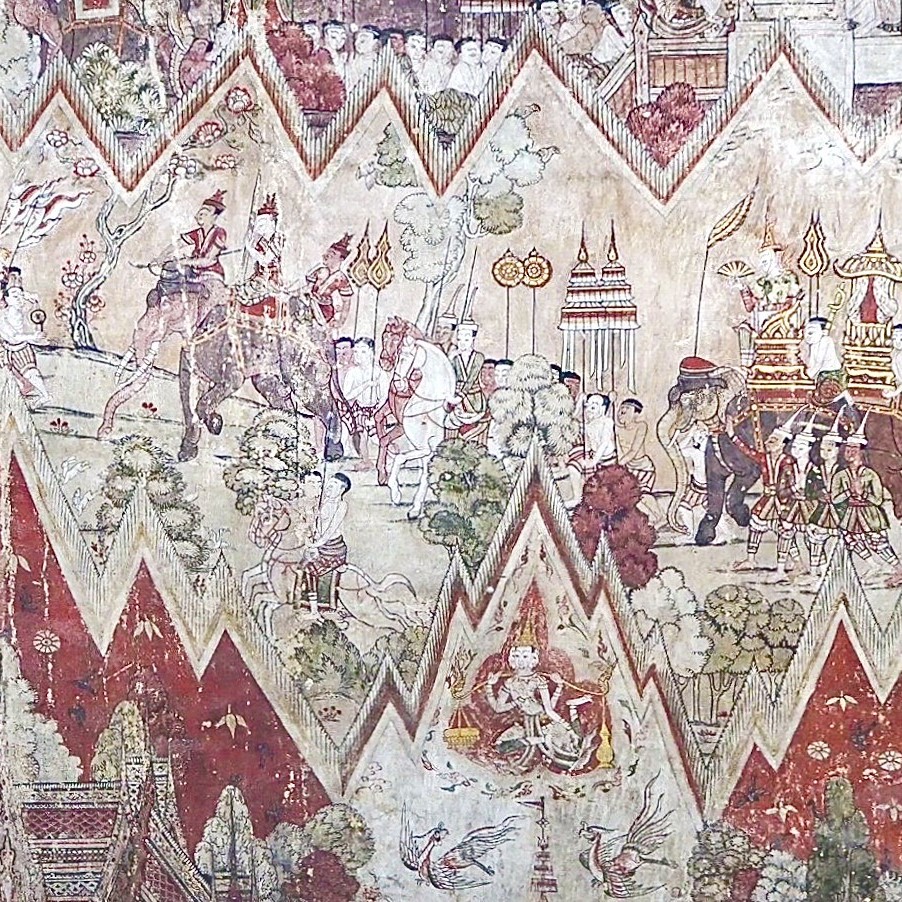Time and Space on Thai Mural Paintings: Case Studies of Wat Chong Nonsi and Wat Prasat
DOI:
https://doi.org/10.69598/sbjfa269060Keywords:
Space and Time , Mural Painting , Multi-Dimensions on a Single Plane , Wat Chong Nonsi , Wat PrasatAbstract
This article investigates mural paintings from the late Ayutthaya Period to comprehend the structural, conceptual, and technical aspects. The study examines time and space in mural paintings depicting the Mahanipata Jataka tales (the Ten Great Birth Stories of the Buddha), commonly portrayed in Buddhist Chapels in the late Ayutthaya period. These murals were passed down through generations, eventually establishing the standardized form of mural paintings in royal temples during the early Rattanakosin period. The paintings are believed to have served as the foundation for the evolution of narrative paintings, both in terms of spatial arrangement and complexity, during the reign of King Rama III. Therefore, revisiting the abovementioned subjects of time and space is deemed essential. The study is conducted by analyzing two case study locations: the mural paintings of Wat Chong Nonsi and Wat Prasat, both renowned for their Ayutthaya period mural paintings. The study reveals that both sets of mural paintings exhibit traces related to space and time concepts through portraying figures, backgrounds, and various compositional techniques. Specifically: 1. Time Representation: The mural paintings of Wat Chong Nonsi and Wat Prasat delineate time into three distinct categories: 1) Momentary time, 2) Short-continuous time, and 3) Long-continuous time. 2. Space Depiction of three-dimensional space in two-dimensional mural paintings: Both temples employ similar narratives conveyed with different techniques. Wat Prasat utilizes semi-circular or U-shaped forms to encapsulate the central focal point, imbuing the composition with a three-dimensional perspective. Conversely, Wat Chong Nonsi favours the depiction of three-dimensional architectural forms and suburban scenes, evoking the pictorial space reminiscent of Chinese landscape paintings.
Downloads
References
ชินวรสิริวัฒน์, สมเด็จพระสังฆราชเจ้า กรมหลวง. (2560ก). มหานิบาตชาดก ทศชาติฉบับชินวร 1. โรงพิมพ์มหามกุฏราชวิทยาลัย.
________. (2560ข). มหานิบาตชาดก ทศชาติฉบับชินวร 2. โรงพิมพ์มหามกุฏราชวิทยาลัย.
ศิลป พีระศรี, เฟื้อ หริพิทักษ์ และ เขียน ยิ้มศิริ. (2506). จิตรกรรมฝาผนังสกุลช่างนนทบุรี. คณะจิตรกรรมและปฏิมากรรม มหาวิทยาลัยศิลปากร.
สน สีมาตรัง. (2528). รายงานวิจัยวิธีอนุรักษ์จิตรกรรมฝาผนังวัดช่องนนทรี. มหาวิทยาลัยศิลปากร.
Bhirasri, S., Haripitak, F. & Yimsiri, K. (1963). Murals of Nondburi School. The Faculty of Painting and Sculpture, Silpakorn University. [in Thai]
Jinavorn Sirivaddhana, Somdet Phra Sangharaja Chao Kromma Luang. (2017a). Mahānipāta Jātaka, Janavara Version I. Mahamakuta Rajavidyalaya Foundation. [in Thai]
______. (2017b). Mahānipāta Jātaka, Janavara Version II. Mahamakuta Rajavidyalaya Foundation. [in Thai]
Srimatrang, S. (1985). Research Report: Conservation Methods for Mural Paintings of Wat Chong Nonsi. Silpakorn University. [in Thai]

Downloads
Published
How to Cite
Issue
Section
License
Copyright (c) 2024 © by the Author(s) & Silpa Bhirasri Journal of Fine Arts.

This work is licensed under a Creative Commons Attribution-NonCommercial-NoDerivatives 4.0 International License.
The journal's editorial team does not have to agree with the views and comments in the author's article, nor are they responsible for the comments.











